Page 262 of 417
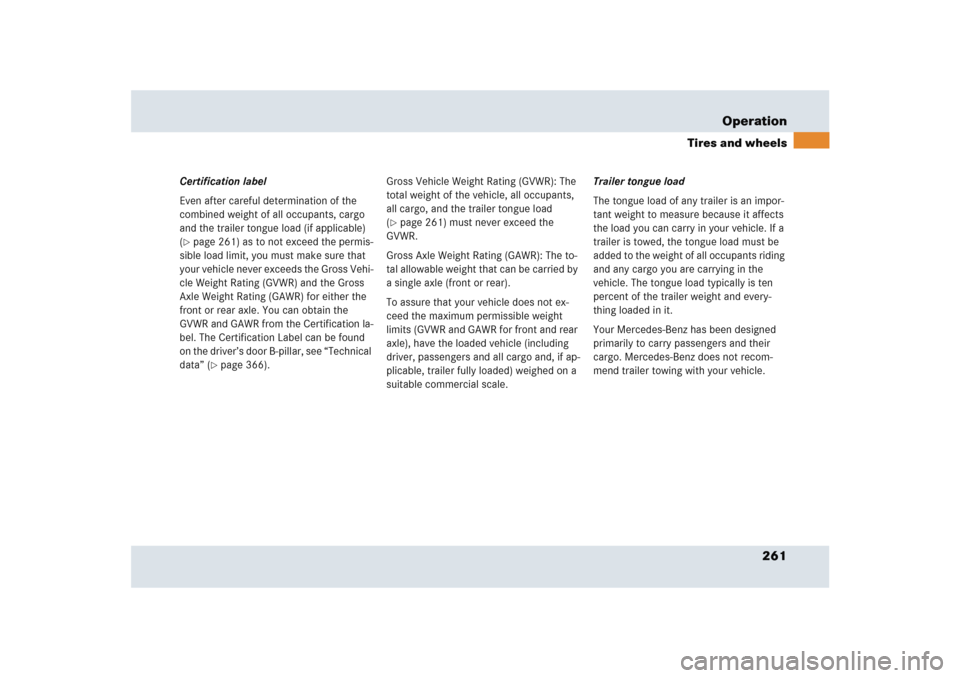
261 Operation
Tires and wheels
Certification label
Even after careful determination of the
combined weight of all occupants, cargo
and the trailer tongue load (if applicable)
(�page 261) as to not exceed the permis-
sible load limit, you must make sure that
your vehicle never exceeds the Gross Vehi-
cle Weight Rating (GVWR) and the Gross
Axle Weight Rating (GAWR) for either the
front or rear axle. You can obtain the
GVWR and GAWR from the Certification la-
bel. The Certification Label can be found
on the driver’s door B-pillar, see “Technical
data” (
�page 366).Gross Vehicle Weight Rating (GVWR): The
total weight of the vehicle, all occupants,
all cargo, and the trailer tongue load
(
�page 261) must never exceed the
GVWR.
Gross Axle Weight Rating (GAWR): The to-
tal allowable weight that can be carried by
a single axle (front or rear).
To assure that your vehicle does not ex-
ceed the maximum permissible weight
limits (GVWR and GAWR for front and rear
axle), have the loaded vehicle (including
driver, passengers and all cargo and, if ap-
plicable, trailer fully loaded) weighed on a
suitable commercial scale.Trailer tongue load
The tongue load of any trailer is an impor-
tant weight to measure because it affects
the load you can carry in your vehicle. If a
trailer is towed, the tongue load must be
added to the weight of all occupants riding
and any cargo you are carrying in the
vehicle. The tongue load typically is ten
percent of the trailer weight and every-
thing loaded in it.
Your Mercedes-Benz has been designed
primarily to carry passengers and their
cargo. Mercedes-Benz does not recom-
mend trailer towing with your vehicle.
Page 295 of 417
Practical hintsWhat to do if ...
Where will I find ...?
Locking/unlocking in an emergency
Replacing SmartKey batteries
Replacing bulbs
Replacing the wiper blades
Flat tire
Batteries
Towing the vehicle
Fuses
Page 314 of 417
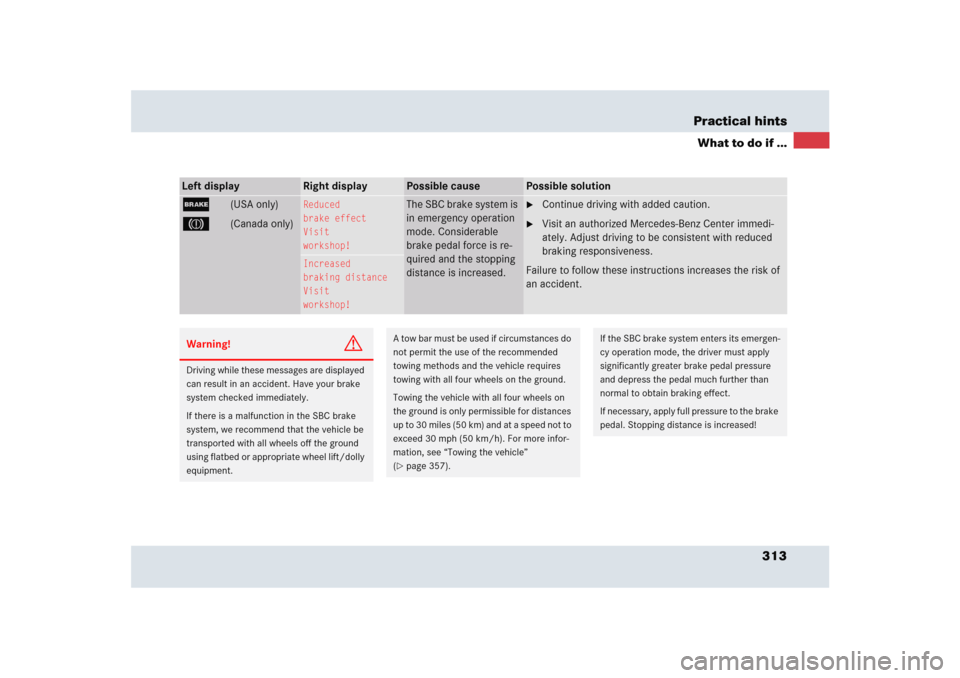
313 Practical hints
What to do if ...
Left display
Right display
Possible cause
Possible solution
;
(USA only)
3
(Canada only)
Reduced
brake effect
Visit
workshop!
The SBC brake system is
in emergency operation
mode. Considerable
brake pedal force is re-
quired and the stopping
distance is increased.
�
Continue driving with added caution.
�
Visit an authorized Mercedes-Benz Center immedi-
ately. Adjust driving to be consistent with reduced
braking responsiveness.
Failure to follow these instructions increases the risk of
an accident.
Increased
braking distance
Visit
workshop!
Warning!
G
Driving while these messages are displayed
can result in an accident. Have your brake
system checked immediately.
If there is a malfunction in the SBC brake
system, we recommend that the vehicle be
transported with all wheels off the ground
using flatbed or appropriate wheel lift/dolly
equipment.
A tow bar must be used if circumstances do
not permit the use of the recommended
towing methods and the vehicle requires
towing with all four wheels on the ground.
Towing the vehicle with all four wheels on
the ground is only permissible for distances
up to 30 miles (50 km) and at a speed not to
exceed 30 mph (50 km/h). For more infor-
mation, see “Towing the vehicle”
(�page 357).
If the SBC brake system enters its emergen-
cy operation mode, the driver must apply
significantly greater brake pedal pressure
and depress the pedal much further than
normal to obtain braking effect.
If necessary, apply full pressure to the brake
pedal. Stopping distance is increased!
Page 341 of 417
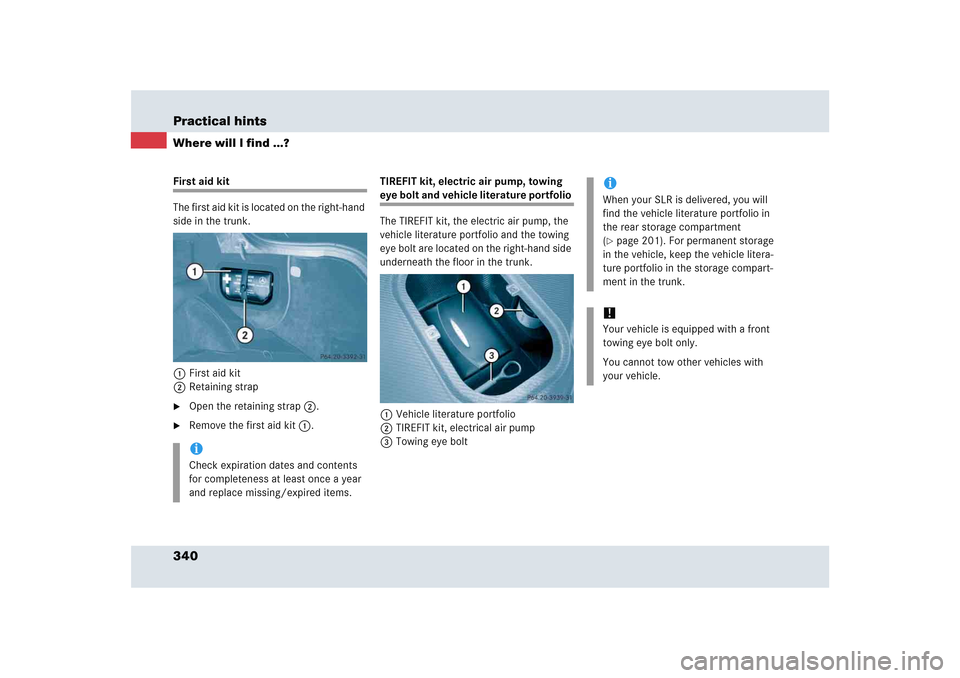
340 Practical hintsWhere will I find ...?First aid kit
The first aid kit is located on the right-hand
side in the trunk.
1First aid kit
2Retaining strap�
Open the retaining strap2.
�
Remove the first aid kit1.TIREFIT kit, electric air pump, towing
eye bolt and vehicle literature portfolio
The TIREFIT kit, the electric air pump, the
vehicle literature portfolio and the towing
eye bolt are located on the right-hand side
underneath the floor in the trunk.
1Vehicle literature portfolio
2TIREFIT kit, electrical air pump
3Towing eye bolt
iCheck expiration dates and contents
for completeness at least once a year
and replace missing/expired items.
iWhen your SLR is delivered, you will
find the vehicle literature portfolio in
the rear storage compartment
(�page 201). For permanent storage
in the vehicle, keep the vehicle litera-
ture portfolio in the storage compart-
ment in the trunk.
!Your vehicle is equipped with a front
towing eye bolt only.
You cannot tow other vehicles with
your vehicle.
Page 358 of 417

357 Practical hints
Towing the vehicle
�Towing the vehicle
Mercedes-Benz recommends that the vehi-
cle be transported with all wheels off the
ground using flatbed or appropriate wheel
lift/dolly equipment.
When circumstances do not permit the
recommended towing methods, the vehi-
cle may be towed with all wheels on the
ground or front wheels raised only so far as necessary to have the vehicle moved to a
safe location where the recommended
towing methods can be employed.
!Use flatbed or wheel lift/dolly equip-
ment with SmartKey in starter switch
turned to position0.
Do not tow with sling-type equipment.
Towing with sling-type equipment over
bumpy roads will damage radiator and
supports.
To prevent damage during transport,
do not tie down vehicle by its chassis or
suspension parts.
Switch off the tow-away alarm and the
automatic central locking.
!If the vehicle is towed with the front
axle raised, the engine must be shut off
(SmartKey in starter switch position0
or1). Otherwise the ESP will immedi-
ately be engaged and will apply the rear
wheel brakes.
When towing the vehicle with all wheels
on the ground, the gear selector lever
must be in positionN and the
SmartKey must be in starter switch
position2.
When towing the vehicle with all wheels
on the ground or the front axle raised,
the vehicle may be towed only for dis-
tances up to 30 miles (50 km) and at a
speed not to exceed 30 mph
(50 km/h).
!To be certain to avoid a possibility of
damage to the transmission, however,
we recommend the drive shaft be dis-
connected at the rear axle drive flange
for any towing beyond a short tow to a
nearby garage.
Page 359 of 417
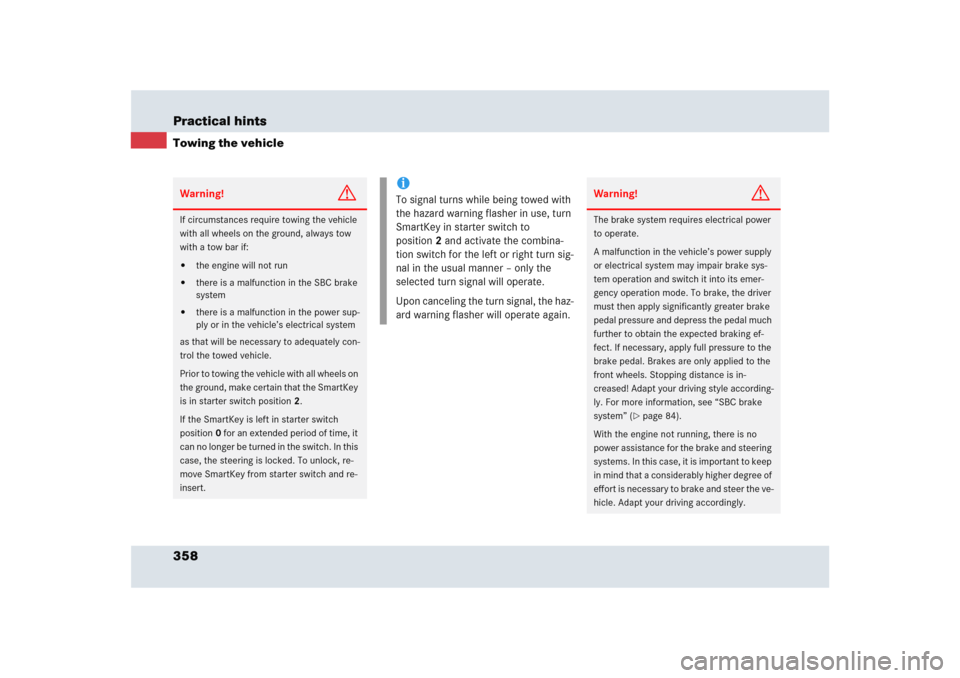
358 Practical hintsTowing the vehicleWarning!
G
If circumstances require towing the vehicle
with all wheels on the ground, always tow
with a tow bar if:�
the engine will not run
�
there is a malfunction in the SBC brake
system
�
there is a malfunction in the power sup-
ply or in the vehicle’s electrical system
as that will be necessary to adequately con-
trol the towed vehicle.
Prior to towing the vehicle with all wheels on
the ground, make certain that the SmartKey
is in starter switch position2.
If the SmartKey is left in starter switch
position0 for an extended period of time, it
can no longer be turned in the switch. In this
case, the steering is locked. To unlock, re-
move SmartKey from starter switch and re-
insert.
iTo signal turns while being towed with
the hazard warning flasher in use, turn
SmartKey in starter switch to
position2 and activate the combina-
tion switch for the left or right turn sig-
nal in the usual manner – only the
selected turn signal will operate.
Upon canceling the turn signal, the haz-
ard warning flasher will operate again.
Warning!
G
The brake system requires electrical power
to operate.
A malfunction in the vehicle’s power supply
or electrical system may impair brake sys-
tem operation and switch it into its emer-
gency operation mode. To brake, the driver
must then apply significantly greater brake
pedal pressure and depress the pedal much
further to obtain the expected braking ef-
fect. If necessary, apply full pressure to the
brake pedal. Brakes are only applied to the
front wheels. Stopping distance is in-
creased! Adapt your driving style according-
ly. For more information, see “SBC brake
system” (
�page 84).
With the engine not running, there is no
power assistance for the brake and steering
systems. In this case, it is important to keep
in mind that a considerably higher degree of
effort is necessary to brake and steer the ve-
hicle. Adapt your driving accordingly.
Page 360 of 417
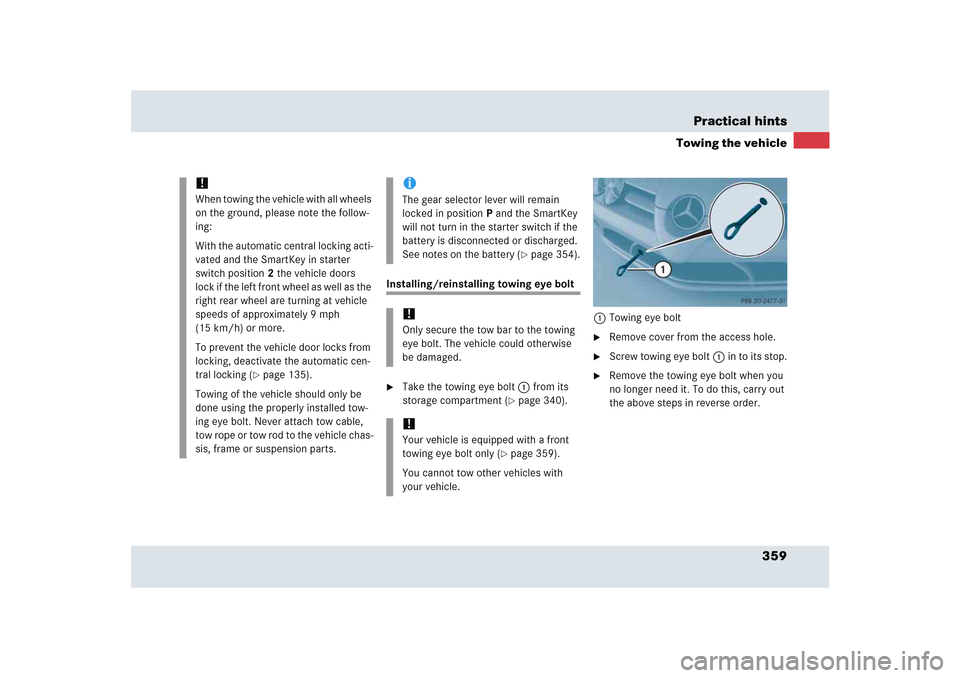
359 Practical hints
Towing the vehicle
Installing/reinstalling towing eye bolt�
Take the towing eye bolt1 from its
storage compartment (
�page 340).1Towing eye bolt
�
Remove cover from the access hole.
�
Screw towing eye bolt1 in to its stop.
�
Remove the towing eye bolt when you
no longer need it. To do this, carry out
the above steps in reverse order.
!When towing the vehicle with all wheels
on the ground, please note the follow-
ing:
With the automatic central locking acti-
vated and the SmartKey in starter
switch position2 the vehicle doors
lock if the left front wheel as well as the
right rear wheel are turning at vehicle
speeds of approximately 9 mph
(15 km/h) or more.
To prevent the vehicle door locks from
locking, deactivate the automatic cen-
tral locking (
�page 135).
Towing of the vehicle should only be
done using the properly installed tow-
ing eye bolt. Never attach tow cable,
tow rope or tow rod to the vehicle chas-
sis, frame or suspension parts.
iThe gear selector lever will remain
locked in positionP and the SmartKey
will not turn in the starter switch if the
battery is disconnected or discharged.
See notes on the battery (
�page 354).
!Only secure the tow bar to the towing
eye bolt. The vehicle could otherwise
be damaged.!Your vehicle is equipped with a front
towing eye bolt only (
�page 359).
You cannot tow other vehicles with
your vehicle.
Page 361 of 417
360 Practical hintsTowing the vehiclePoints to bear in mind�
The vehicle must not be tow-started.
�
If the vehicle is to be towed, only tow it
with all wheels on the ground.
�
If the vehicle has suffered transmission
damage, only tow it with the propeller
shaft disconnected.
�
Before towing the vehicle, make sure
the battery is connected and charged.
Otherwise you will not be able to switch
on the ignition and move the selector
lever to N. There will then be no power
assistance when steering and braking.
Transporting the vehicle
The towing eye bolt can be used to pull the
vehicle onto a trailer or transporter for
transporting purposes.�
Move the selector lever to N.!Due to the low clearance height of the
SLR, care must be taken when loading
and unloading from a transporter to
avoid damaging the vehicle body work.
To secure the vehicle, only tie it down
by the wheels or tires. Otherwise it
could be damaged.